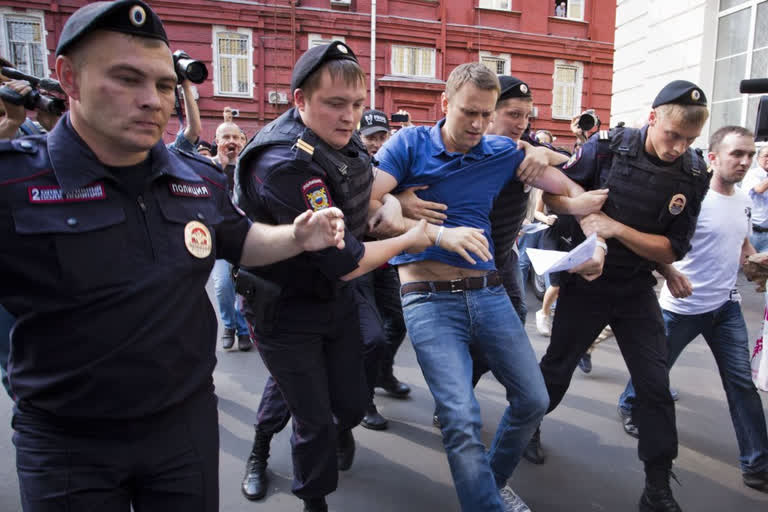Moscow:The return to Russia from Germany by opposition leader Alexei Navalny was marked by chaos and popular outrage, and it ended, almost predictably, with his arrest.
The Jan. 17 flight from Berlin, where Navalny spent nearly five months recovering from a nerve agent poisoning, carried him and his wife, along with a group of journalists documenting the journey. But the plane was diverted from its intended airport in Moscow to another one in the capital in what was seen as an apparent attempt to foil a welcome from crowds awaiting him.
Authorities also took him into custody immediately, sparking outrage at home and abroad. Some Western countries threatened sanctions and his team called for nationwide demonstrations on Saturday which also resulted in several arrests of his supporters across the region.
Navalny had prepared his surprise for his return: A video exposes alleging that a lavish “palace” was built for President Vladimir Putin on the Black Sea through an elaborate corruption scheme. His team posted it on YouTube on Tuesday, and within 48 hours, it had gotten over 42 million views.
Navalny faces years in prison from a previous conviction he claims was politically motivated, while political commentators say there are no good options for the Kremlin.
Let's looks at his long standoff with authorities:
Who is Alexei Navalny?
Navalny, 44, is an anti-corruption campaigner and the Kremlin’s fiercest critic. He has outlasted many opposition figures and is undeterred by incessant attempts to stop his work.
He has released scores of damning reports exposing corruption in Putin’s Russia. He has been a galvanizing figure in mass protests, including unprecedented 2011-12 demonstrations sparked by reports of widespread rigging of a parliamentary election.
Navalny was convicted twice on criminal charges: embezzlement and later fraud. He received suspended sentences of five years and 3 1/2 years. He denounced the convictions as politically motivated, and the European Court of Human Rights disputed both convictions.
Navalny sought to challenge Putin in the 2018 election but was barred from running by one of his convictions. Nevertheless, he drew crowds of supporters almost everywhere he went in the country.
Frequently arrested, he has served multiple stints in jail for charges relating to leading protests. In 2017, an attacker threw a green antiseptic liquid in his face, damaging his sight. He also was hospitalized in 2019 after a suspected poisoning while in jail.
None of that has stopped him. In August 2020, he fell ill while on a domestic flight in Siberia, and the pilot landed quickly in Omsk, where he was hospitalized. His supporters managed to have him flown to Berlin, where he lay in a coma for over two weeks and was diagnosed as having been poisoned by a Soviet-era nerve agent — an allegation the Kremlin denied.
After he recovered, Navalny released a recording of a phone call he said he made to a man he alleged was a member of Russia’s Federal Security Service, or FSB, who purportedly poisoned him. The FSB dismissed the recording as a fake, but it still shocked many at home and abroad.
Navalny vowed to return to Russia and continue his work, while authorities threatened him with arrest.
Why did Navalny return at all?
Navalny said he didn’t leave Russia by choice, but rather “ended up in Germany in an intensive care box.” He said he never considered the possibility of staying abroad.
“It doesn’t seem right to me that Alexei Navalny calls for a revolution from Berlin,” he explained in an interview in October, referring to himself in the third person. “If I’m doing something, I want to share the risks with people who work in my office.”
Analysts say it would have been impossible for Navalny to remain relevant as an opposition leader outside Russia. “Remaining abroad, becoming a political emigre, would mean death to a public politician,” said Masha Lipman, an independent political analyst.
